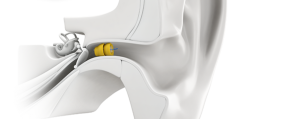UNLOCKING THE SECRETS OF “THE HUM”: A MEDICAL PERSPECTIVE

23 September 2023
The mysterious phenomenon known as “the Hum” has puzzled scientists, doctors, and the general populace for decades. This persistent, low-frequency noise is audible to only about 2% of people globally, yet its impact is often debilitating, affecting sleep, causing stress, and even contributing to symptoms like nausea and headaches. Let’s shed light on this enigmatic issue, particularly because its nature and possible origins intersect with topics directly related to auditive health.
Historical Background
When it comes to the Hum, its history is as elusive as the sound itself. While some believe that the phenomenon may have roots going back to the Industrial Revolution of the 19th century, it wasn’t until the 1970s that the Hum began to earn scientific acknowledgment. Regardless of its origins, one thing is for sure: the Hum is not a new sensation but rather a mysterious, age-old hum that we have yet to fully understand.
Characteristics and Impact
Those who report experiencing the Hum often describe it as a distant noise, akin to the rumble of a running diesel engine. Generally, the frequency is low, below 100 Hz, making it even more mysterious. However, its effects are decidedly not subtle; from insomnia and headaches to nausea and stress, the Hum has a tangible impact on quality of life for those who can hear it. If you find yourself in this rare but unfortunate group, it is crucial to seek professional medical help to manage symptoms.
Low-Frequency Sounds and Infrasounds
The Earth is no stranger to low-frequency sounds and infrasounds. Natural phenomena such as earthquakes, tsunamis, and storms, as well as human-induced sounds like transport and machinery, contribute to the cacophony. The complexity lies in measuring these sounds, primarily because they fall below the threshold of what we typically perceive as sound.
Possible Origins
When it comes to explaining the Hum, theories abound, but concrete answers are hard to come by.
– Internal Ear Phenomena: Some researchers believe the cochlea, the spiral-shaped tube in the inner ear, could be emitting the Hum. While this makes for an interesting hypothesis, ear-related phenomena of this sort are relatively common and don’t align with the rare occurrence of the Hum.
– Vascular Phenomena: Another theory points to a “venous hum,” a benign vascular occurrence that might be responsible. Yet, much like internal ear phenomena, this is too prevalent to explain the Hum adequately.
– Tinnitus: The idea that the Hum is a form of low-frequency tinnitus is appealing, especially given the symptoms it produces. But had it been the case, it’s likely the Hum would have been identified much earlier in medical literature.
– Anthropogenic Factors: Some have speculated that human-made sources like pipelines and power transformers could be the culprits. However, no definitive proof has been established to back this claim.
– Electromagnetic Hypersensitivity: Although some individuals assert that electromagnetic waves cause the Hum, scientific evidence remains inconclusive.
Mitigating the Effects with Hearing Aids
For those plagued by the mysterious Hum, the question often turns from “What is it?” to “How do I make it stop?” One avenue that has gained attention is the use of specialized hearing aids designed to mitigate the effects of low-frequency noises. Now, you might think of hearing aids as devices that amplify sound, and you’re not wrong. However, modern hearing aids come equipped with advanced features that not only amplify specific frequencies of sound but can also attenuate or block others.
Customization and Noise Filtering

Today’s hearing aids can be customized to a patient’s specific hearing profile. High-precision microphones and advanced software algorithms help in identifying and categorizing sounds. This customization could theoretically allow the hearing aid to recognize the frequency of the Hum and either filter it out or introduce a masking sound to neutralize its effects.
Tinnitus Masking Features
Some hearing aids come with tinnitus masking features, which could be beneficial if the Hum is indeed a form of low-frequency tinnitus for some individuals. These features create a “white noise” or a different sound pattern to make the disturbing sound less noticeable.
Cognitive Behavioral Therapy (CBT) Integration
Advanced hearing aids offer integration with cognitive behavioral therapy apps that can be controlled via smartphones. If the Hum is causing significant stress or insomnia, a combination of sound masking and cognitive behavioral techniques may provide relief.
Professional Consultation
perform a comprehensive examination and hearing test. The data collected can then be used to determine if a specialized hearing aid may alleviate the symptoms. Keep in mind that while hearing aids offer a promising solution, they are not universally effective for all types of the Hum and should be considered as part of a broader treatment plan.
The Hum remains an enigma with multiple facets and dimensions. While we don’t have all the answers, advancements in audiological technology offer a glimmer of hope for those affected by this perplexing phenomenon. Specialized hearing aids, when used under the guidance of medical professionals, can potentially mitigate the impacts of the Hum, offering sufferers a much-needed reprieve from its disruptive effects. Until the mystery is entirely unraveled, a multi-pronged approach, combining scientific research and innovative medical solutions, appears to be the most effective strategy for tackling the Hum’s many complexities.
References
- Manifestations of a low-frequency sound of unknown origin perceived worldwide, also known as “the Hum” or the “Taos Hum” : https://pubmed.ncbi.nlm.nih.gov/27488996/
- The history of the mysterious world wide hum explained: https://www.grunge.com/735994/the-history-of-the-mysterious-world-wide-hum-explained/
- A Maddening Sound : https://newrepublic.com/article/132128/maddening-sound
- Hum hum : et le mystère des sons entendus sur la planète : https://atlantico.fr/article/decryptage/hum-hum–et-le-mystere-des-sons-entendus-sur-la-planete-s-eclaircit-enfin-volcan-sous-marin-ocean-indien-gerald-delfolie
- Carte des lieux de l’Hum : https://thehum.info/newhummap/html_docs/
- Have you heard the Hum? BC man investigates strange sound heard around the world https://globalnews.ca/news/2644848/have-you-heard-the-hum-bc-man-investigates-strange-sound-heard-around-the-world/
- Thousands of people around the world are hearing a strange ‘Hum’ – we speak to the scientist working out why https://ca.style.yahoo.com/thousands-people-around-world-hearing-strange-hum-one-scientist-hopes-find-144025258.html
- Deming, D. The Hum: An Anomalous Sound Heard Around the World https://waubrafoundation.org.au/resources/deming-d-hum-an-anomalous-sound-heard-around-world/
Autres articles
PROGRESSIVE HEARING LOSS WITH AGE: IS IT INEVITABLE?
As we get older, all our organs age, and the cells of the inner ear are no exception. It’s a…
RECEIVER IN THE EAR: WHAT ARE THE TECHNOLOGICAL ADVANCES ?
Why is it important to correct hearing impairments? The danger of hearing loss It’s a health problem that’s far too…
CONSULT AN ENT SPECIALIST IN CASE OF VERTIGO
Often, people suffering from vertigo – that is to say, a strong sensation of dizziness and a loss of balance…


